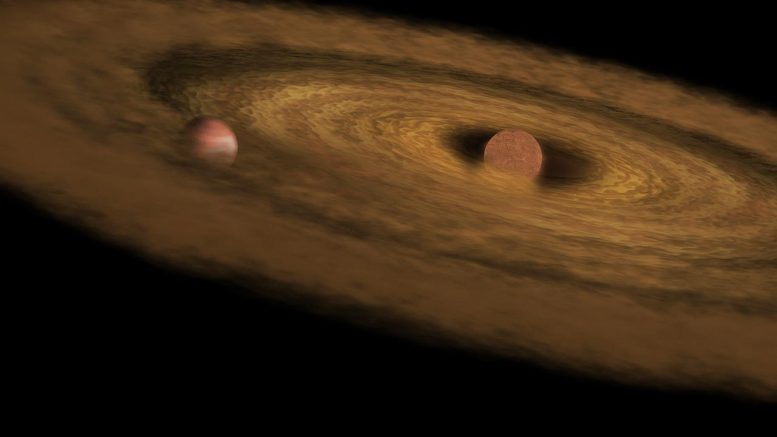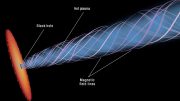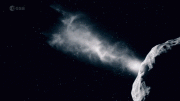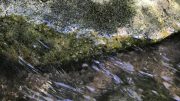
An artist’s conception of a young brown dwarf star with its dusty disk, and with an orbiting planet. New research on these dust disks suggests that material in the cold, outer disk may have migrated there from inner regions. Credit: ESA
While using infrared spectra from the Spitzer Space Telescope to analyze the dust in several young brown dwarf disks, scientists discovered that the cold outer regions of such disks often contained grains crystalline in structure and not amorphous.
Small dust particles in a disk of gas around a young star, according to current models, gradually coagulate during the first million years until kilometer-sized objects are formed. These in turn coalesce and grow into planets. The processes at work depend in part on the chemical composition of the dust grains and how their sizes, shapes, and structures evolve.
The most dominant dust species in circumstellar material are thought to be oxygen-rich silicates (typically minerals containing magnesium and iron as well as silicon and oxygen). Besides coming in a range of shapes and sizes, these grains can either have a crystalline (that is, highly ordered) structure, or its opposite, an amorphous structure. Grains that grow by gradual coalescence are amorphous, but if during their lifetime they were heated to near-melting temperatures and then cooled, crystalline structures develop. These differences can be observed in the infrared by astronomers, because dust grains emit most strongly at wavelengths of radiation that are approximately the same as their size, with details depending on these structural differences. The spectral behavior of dust emission, therefore, makes it possible to determine the properties of the dust grains in a disk, and even to infer the history.
Harvard-Smithsonian Center for Astrophysics (CfA) astronomer Mario Guarcello and his colleagues undertook an infrared study of disk dust grains in an effort to probe the nature of protoplanetary development, and specifically to look for evidence of grain processing via heating (in particular, crystalline versus amorphous grains) in different regions of the disk, perhaps the result of local heating due to shocks or collisions. They chose to examine the disks of young brown dwarf stars. These stars have masses less than about 8% of the Sun’s, and lack sufficient gravitational contraction to heat up their interiors to the roughly ten million kelvin temperatures needed for hydrogen burning (hydrogen burning fuels the Sun). Instead, they burn more dimly by the power of deuterium fusion. Only about twenty percent of brown dwarf stars five million years old show evidence for dust emission from disks. The combined evidence is that grain growth, crystallization, and the production of other dust grain characteristics are probably completed by the time a brown dwarf is only a million years old.
The scientists used infrared spectra from the Spitzer Space Telescope to analyze the dust in each of a set of twenty very young brown dwarf disks. They report finding that, contrary to conventional wisdom that the cold, outer regions of such disks should have amorphous grains, the cold grains there are often crystalline: Something happened in the first million years to heat them to melting temperatures. What this was is still not known. It might be a local phenomenon, perhaps a shock wave, or it might be that these grains were originally closer to the star and migrated outward to the cold regions. The astronomers note a tantalizing analogy to comets in our solar system, which — curiously — also have crystalline grains even though they reside in the cold outer regions. Maybe comets also formed closer in to the Sun and then migrated out? The new paper answers some questions while refining others, and is a good example of the important progress being made today in understanding how planets and planetary systems form.









Be the first to comment on "Curious Findings from Early Stages of Planet Formation"